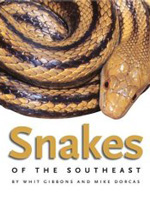Review of "Snakes of the Southeast"

Author(s): Whit Gibbons & Mike Dorcas
Published: May 2005, University of Georgia Press, ISBN: 0820326526
by Michael L. McMahan, Ph.D., University Professor of Biology
August 234, 2005 -
Quite apparently, there is an innate fear of snakes in the human psyche – probably dating to the well-known incident in the Garden of Eden; however, many persons (self included) find snakes to be intriguing and (believe it or not) actually beautiful. Whit Gibbons and Mike Dorcas have authored a book entitled Snakes of the Southeast (University of Georgia Press, 2005) that not only proves to be of great educational value – but also features more than 300 beautiful color photographs of the species of snakes that occur in the southeastern United States.
The first chapter of the book serves as a general introduction to snakes and their diversity, anatomy, reproduction, and defense – as well as other aspects of their biology. It also includes a section on how to identify different species of snakes and how to differentiate between venomous and nonvenomous species.
The next major portion of the book consists of species accounts of the 52 species of snakes that are known to occur in the southeast – almost half of the North American species. This new book is a comprehensive, detailed examination of these snakes that will prove to be of great value to both the layman and biologist. For each species, the authors have provided a general description and also information on color variations, reproduction, description of the young, distribution, habitat, general behavior, diet and feeding, predators, defensive mechanisms, and conservation. In addition, for each species, there are multiple photos and a distribution map along with a size chart and easily accessible identification information.
One very interesting and helpful feature of the species account section is its examination of numerous terrestrial snakes arranged by size, starting with small species (frequently only 8-10” in length at maturity!) and progressing to snakes such as the coachwhip that can “max out” at 8-9 feet! The authors have chosen then to examine, in succession, nonvenomous watersnakes, venomous snakes, and introduced species. The separate listings for terrestrial, aquatic, and venomous species provide great assistance for the identification of snakes. Although this book was not published to serve as a field guide and is a bit oversized for such (7-3/4 x 10-1/4”), it still would be indispensible for anyone to carry along in order to identify snake species.
The final textual portion of the book considers such topics as herpetology, snakes that commonly occur in locations frequented by people, snakes as pets, snake conservation, and attitudes about snakes. The authors close their book with several very useful features: a chart listing all species occurring in the southeastern United States and indicating the species occurring in each state, summary distribution maps, glossary, and a list of recommended readings.
Many of my former students have heard me mention that one of the highlights of my years as a zoologist was the half hour or so that a friend and I spent in a southern Louisiana pine forest years ago – keeping pace with a coral snake that was moving slowly along the shaded forest floor. This species must be one of the most beautiful results of God’s creative efforts! I never will forget the thrill of being able to observe this individual snake. Even if one never were to encounter a snake in the wild (of course, highly unlikely!), this book, through both text and photos, transports the reader through the fascinating world of the snakes of the southeastern U. S. It should be in every school library and is highly recommended reading for anyone who is not repulsed by the very thought of snakes!

